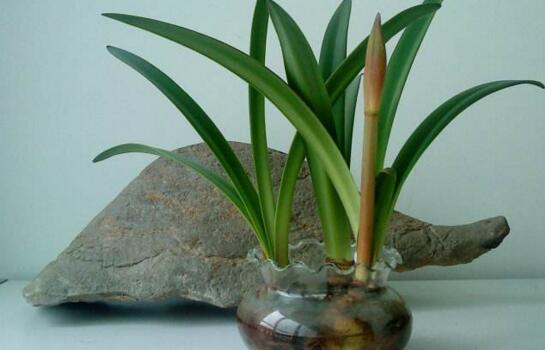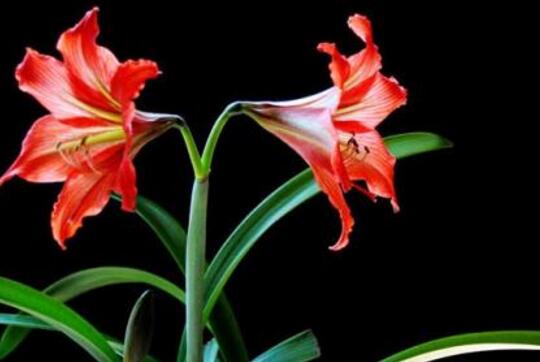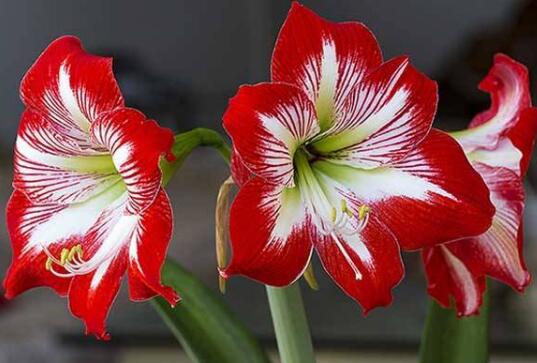Can Zhu Dinghong be cultured in water? the method of water culture of Zhu Dinghong / reasonable addition of nutrient solution
Zhu Dinghong is a plant of the genus Liliaceae, whose fresh stems are very spherical, so some people often want to plant it in the way of hydroponic culture to achieve a better ornamental effect, so can it be hydroponically cultivated? The answer is yes. Today we will learn about Zhu Dinghong's method of hydroponics.
Can Zhu Dinghong be cultured in water?

Zhu Dinghong can be hydroponically cultured, and its fresh stem is usually about 5 cm in diameter, accompanied by creeping branches, and the flower stem is hollow and slightly flat; the length of the style is usually about 10 cm, so it is very suitable for hydroponic culture from the plant shape.
Hydroponic culture method of Zhu Dinghong
1. Select plants
In order to ensure the smooth survival of Zhu Dinghong after hydroponic culture, the bulbs of more than 3 years old should be used mainly, and the diameter of the bulb should be more than 6 cm. The leaves should be cut off before autumn, and then controlled watering to let the autumn stem go dormant in winter. It can help to bloom smoothly after hydroponic culture.
2. Colonization
Wait until the spring of the second year, take out the bulb and soak it in potassium permanganate solution, clean up the soil to the root, cut off the old root, and fix it on the selected container.
3. Add water
After fixing the plant, add water to the container, the water level does not need to be too high, so as to submerge 1/3 of the bulb, you can put some stones or gravel at the bottom of the container, which can help fix the root system and make Zhu Ding red more beautiful after hydroponic culture.
4. Transplant
When the autumn stem takes root, when the root length reaches 0.5 cm, it can be transplanted into a hydroponic container. In Zhu Dinghong's hydroponic culture method, the choice of container is very critical, which can ensure the growth of Zhu Dinghong's combat strength.
Matters needing attention in water culture of Zhu Dinghong
1. Temperature control. In hydroponic culture, the temperature should be kept between 10-20 degrees, do not let the temperature below 5 degrees, otherwise the hydroponic Zhu Dinghong not only should not survive, but will be easy to freeze.
2. Add nutrient solution. The concentration of the nutrient solution is usually 1/2 of the standard concentration, and after each change of water, the nutrient solution needs to be added, which can provide the nutrients needed for the growth of red red.
3. Change water. Depends on the growth of Zhu Dinghong, but generally in 7-10 days or so need to change the water, do not let the root all soak in water, avoid root rot, if there is a rotten root phenomenon can even be cut off.
Can Zhu Dinghong be cultured in water? Aquaculture method of Zhu Dinghong
Picture: Zhu Dinghong hydroponics
[FAQ] can Zhu Dinghong be cultured in water? Aquaculture method of Zhu Dinghong
[expert answers]
The cultivation method of Zhu Dinghong is generally planted directly in the soil outdoors, and potted plants are also chosen indoors, but recently many flower friends have used the method of hydroponic culture to cultivate Zhu Dinghong. Then the following editor will introduce the hydroponic culture method of Zhu Dinghong.
The method of water culture of Zhu Dinghong:
The main results are as follows: 1. After the red bulb of Zhu Ding grows about the root of 0.5CM, move the red red into a clean water culture container, straighten it with a water culture frame, the water depth should be half of the immersion bulb, and finally put it in a sunny place indoors. Keep the room temperature about 10-20 ℃, check the culture bottle regularly, and change the water in time. Change the water every 2-3 days in the first half month, and then change the water every 4-5 days. The water level in the basin is always kept above the original water level.
2. In order to make the plant grow better and the flowers bloom more brightly, you can replenish fertilizer regularly when the leaves grow to 2-3CM, adding 1% urea solution or 0.03% potassium dihydrogen phosphate or other compound fertilizer solution containing nitrogen, phosphorus and potassium every 10-20 days.
3. Hydroponic Zhu Dinghong can still blossom the following year. When the weather is warm after flowering, it will be moved into the basin soil to continue cultivation. At that time, as long as a little more water and fertilizer are applied, it can quickly recover its vitality and become a strong seedling, which can be continuously hydroponized in winter.
4. When the flowers of Zhu Dinghong begin to decline after fully blooming, cut off the scape from the 2CM of the stem, so as not to compete for nutrition from other developing scape or leaves, and at the same time do not hurt the leaves. Leaves keeping healthy and exuberant photosynthesis can produce and accumulate nutrients for the second flowering in the second year. The red leaf shape of Zhu Ding is very beautiful, even after the whole flower, it can also be used as a green plant to observe the leaves, and when the weather turns warm, it can be moved into the pot soil to continue cultivation.
[editor's comments] Zhu Dinghong water culture method is very simple, similar to daffodil culture, but daffodils often can not blossom in the second year, but Zhu Dinghong can, as long as you pay attention to applying fertilizer and water to restore its vitality. The above first agricultural economic editor introduced Zhu Dinghong's water culture method to you, interested friends can try to see whether soil culture is better, or water culture is more interesting.
Can Zhu Dinghong be cultured in water? the method of water culture in Zhu Dinghong
Zhu Dinghong likes a warm, moist and sunny environment, which requires cool summer and warm winter. It is a flowering plant, which is cultivated in soil and seldom raised in water. If it is half-immersed in water, the snow-white roots and green leaves set off the brightly colored flowers, which is particularly elegant and beautiful. Many flower friends have asked Zhu Dinghong can be hydroponic, what is the method of Zhu Dinghong hydroponics? The following editor will answer for you.
Can Zhu Dinghong be cultured in water?
Zhu Dinghong can be hydroponically cultivated, and hydroponic Zhu Dinghong is very simple. In early winter, choose one or more blooming or unflowered big balls, cut off all the roots and leaves of Zhu Dinghong, peel off the black-brown skin of the outer layer, reveal white and green, and soak in clean water. After about 48 hours, take out the red ball of Zhu Ding, wash off the paste of the incision with clean water, dry and put it into a prepared container.
The containers of Shuipeizhu Dinghong can be bowls, pots or daffodils, etc., put into washed pebbles, perlite, water-absorbing rocks, etc., and then put on the treated Zhu Dinghong bulbs. Then pour in clear water, preferably clear spring water (if tap water is used, it must be placed for a few days). The depth of the water should be about 1 cm lower than that of cushions such as pebbles or flower utensils.
At room temperature about 10 ℃, leaves and roots began to grow in about 7-10 days. The water in the basin should always be kept at the original water level. At the end of the next spring, the bulbs with roots were planted in flowerpots for routine maintenance. In this way, the hydroponic bulbs bloom a little later than other conventional potted plants, just in time for the summer blooming period.
Water culture method of Zhu Dinghong
1. Temperature: the best temperature for hydroponic growth of Zhu Dinghong indoors is 20 ℃-25 ℃, preferably no less than 10 ℃. The cooler temperature will delay the growth and flowering of Zhu Dinghong.
two。 Change water: check Zhu Dinghong's culture bottle regularly and change the water in time. Change the water every 2-3 days in the first half month, and then every 4-5 days. The water level in the basin is always on the original water level.
3. Pruning: when Zhu Dinghong's flowers begin to decay after full bloom, cut off the scape from the 2cm of the stem, so as not to compete for nutrition from other developing scape or leaves, and do not harm Zhu Ding red leaves. Keeping leaves healthy and exuberant photosynthesis can produce and accumulate nutrients for re-flowering in the second year.
4. Fertilization: when the leaves grow to 2-3 cm, fertilizers should be added in time, and 1% urea solution or 0.03% potassium dihydrogen phosphate solution or other compound fertilizer solution containing nitrogen, phosphorus and potassium should be added every 10-20 days.
The above is the article that Zhu Dinghong can be cultured in water, and the method of water culture. In order to make the red flowers bloom better, you might as well add a little inorganic fertilizer to the newly changed water after the scape outcrop every week to make it a very thin inorganic liquid fertilizer. When the scape grows to about 3 cm, raise the ambient temperature to about 25 degrees. When the bud is about to open, put the plant in a cool place with an ambient temperature of about 10 degrees, which can make the red flower more colorful and bloom longer.
- Prev

How to raise Zhu Dinghong, Zhu Dinghong's breeding methods and matters needing attention / temperature are the key points.
It is well known that Zhu Dinghong has a lot of functions and effects, so the number of people who raise it is also increasing, but some flower lovers do not know very much about Zhu Dinghong, so they do not know how to raise Zhu Dinghong. Today, the editor will take you to learn about Zhu Dinghong's breeding methods and matters needing attention.
- Next

How to fertilize Zhu Dinghong, what fertilizer / base fertilizer / phosphorus and potassium fertilizer Zhu Dinghong can apply?
We have emphasized in Zhu Dinghong's culture method that fertilization is very important. Too little fertilization will affect the flowering time or even lead to non-flowering, while too much fertilization will lead to weak plant growth, so how can Zhu Dinghong apply fertilizer more scientifically? What kind of fertilizer should Zhu Dinghong apply? The editor came to tell you the answer.
Related
- Fuxing push coffee new agricultural production and marketing class: lack of small-scale processing plants
- Jujube rice field leisure farm deep ploughing Yilan for five years to create a space for organic food and play
- Nongyu Farm-A trial of organic papaya for brave women with advanced technology
- Four points for attention in the prevention and control of diseases and insect pests of edible fungi
- How to add nutrient solution to Edible Fungi
- Is there any good way to control edible fungus mites?
- Open Inoculation Technology of Edible Fungi
- Is there any clever way to use fertilizer for edible fungus in winter?
- What agents are used to kill the pathogens of edible fungi in the mushroom shed?
- Rapid drying of Edible Fungi

